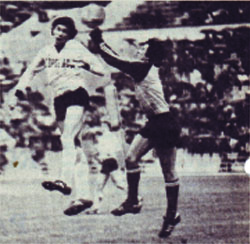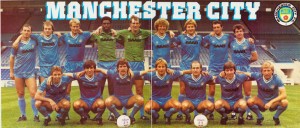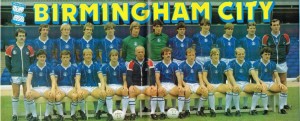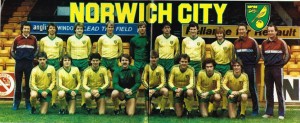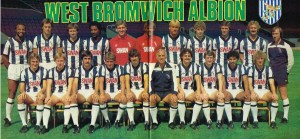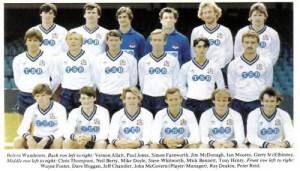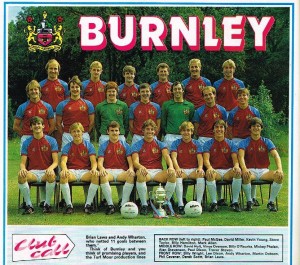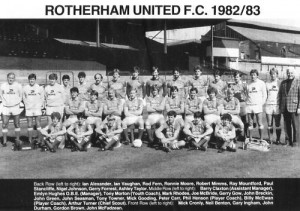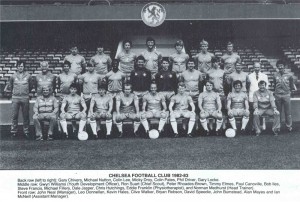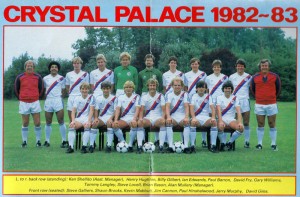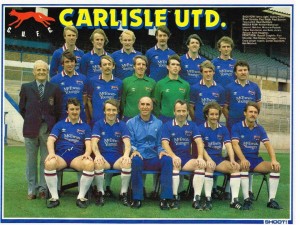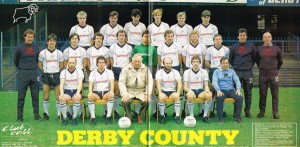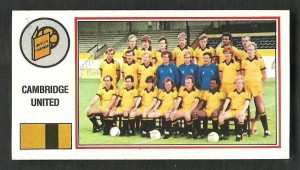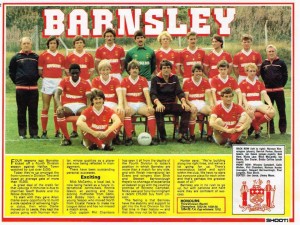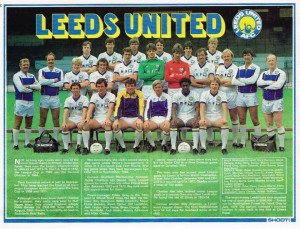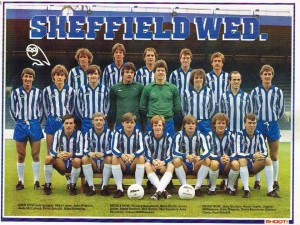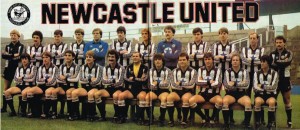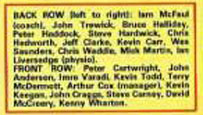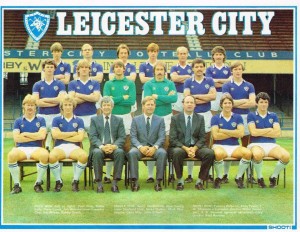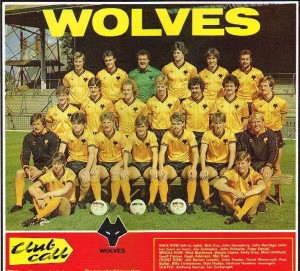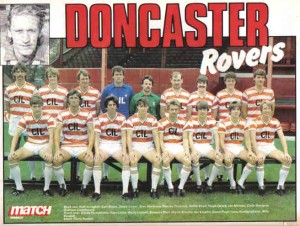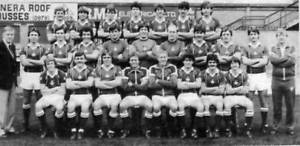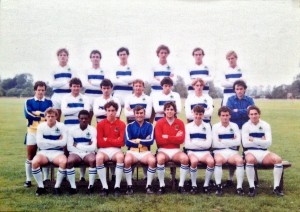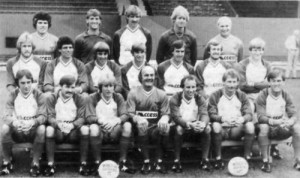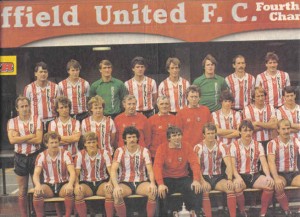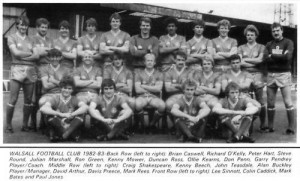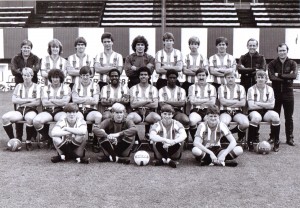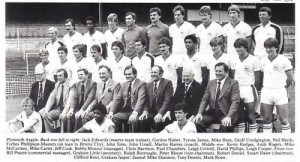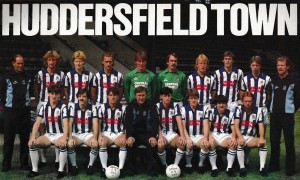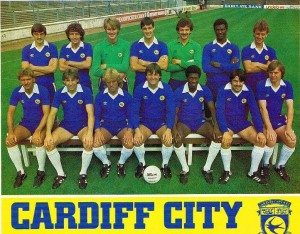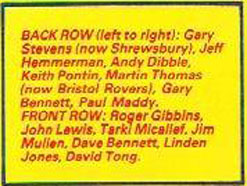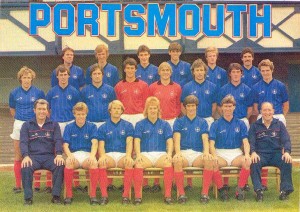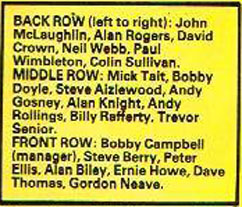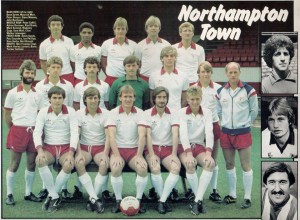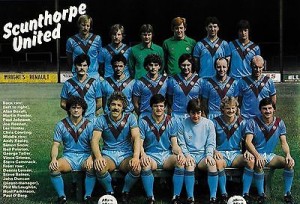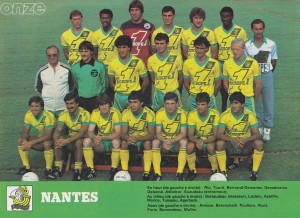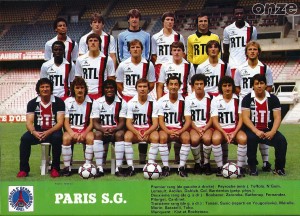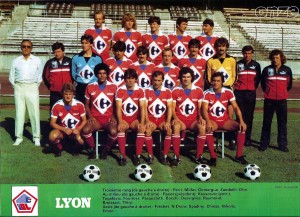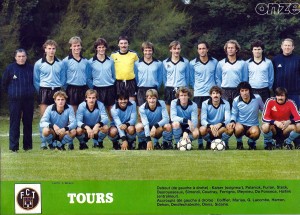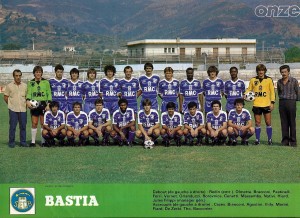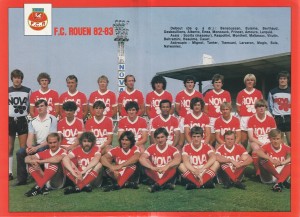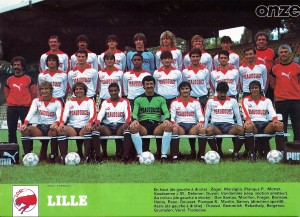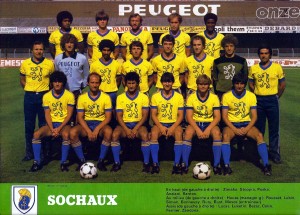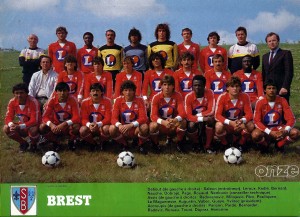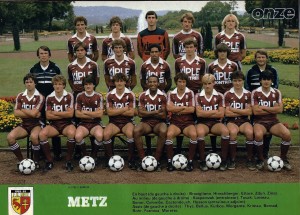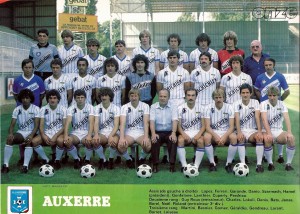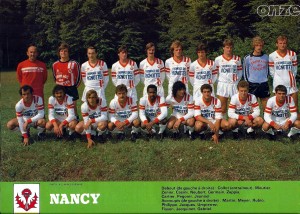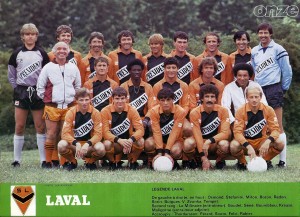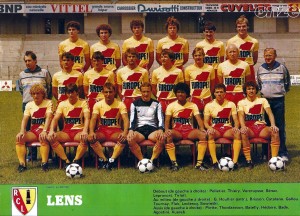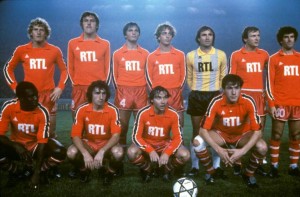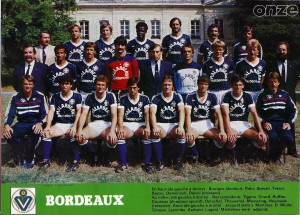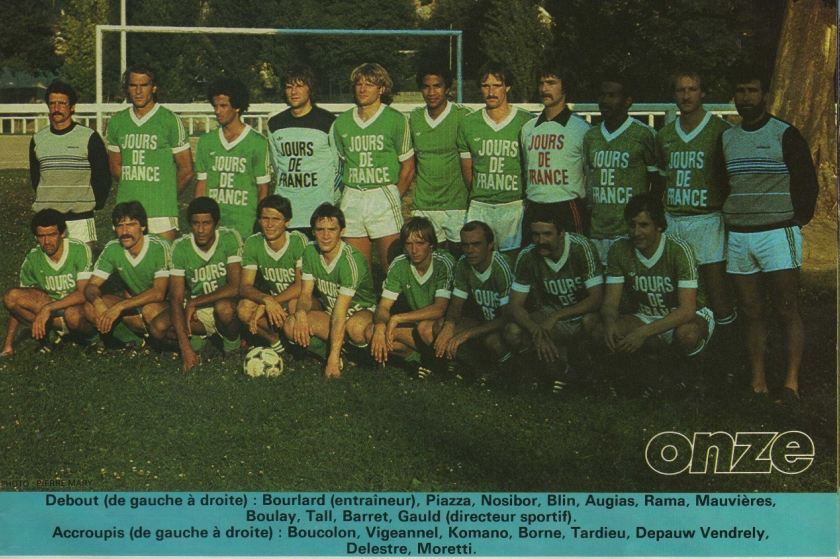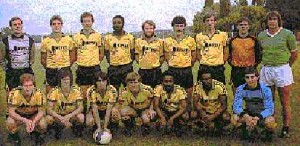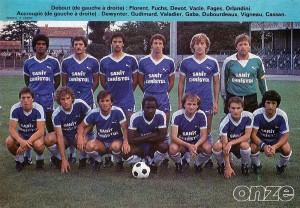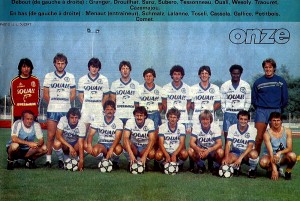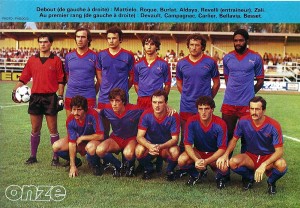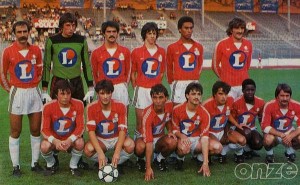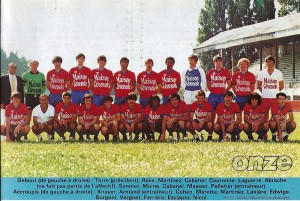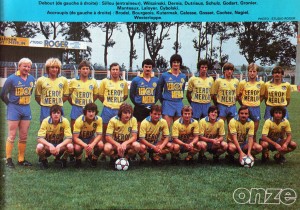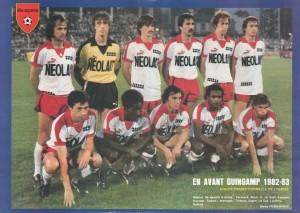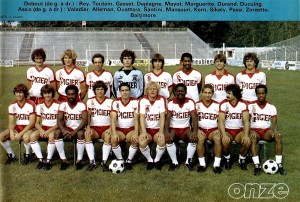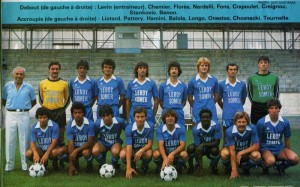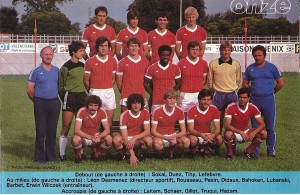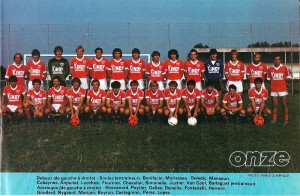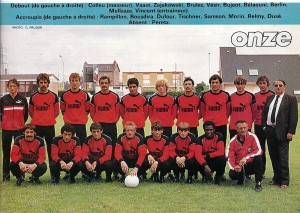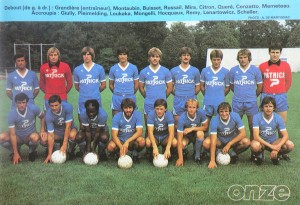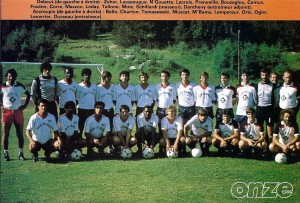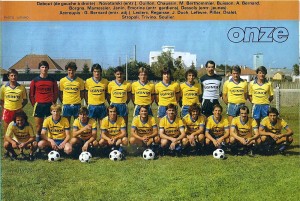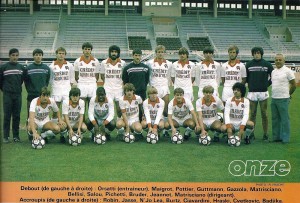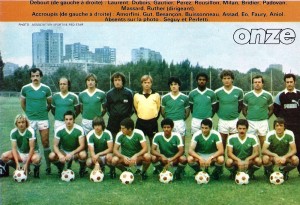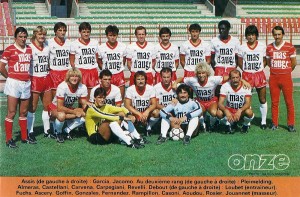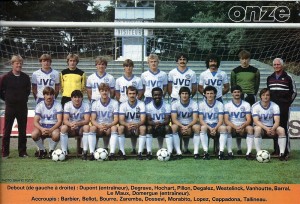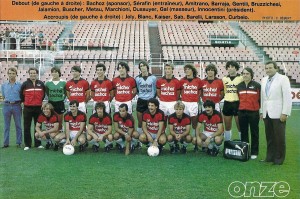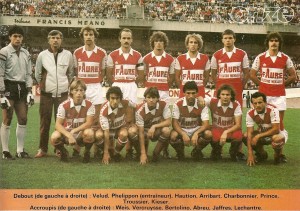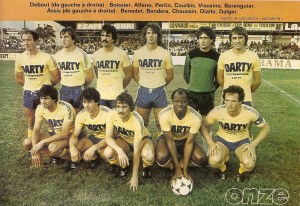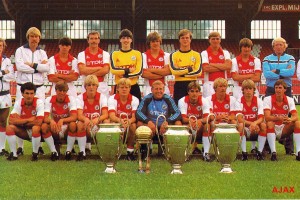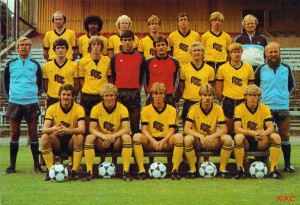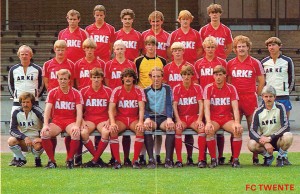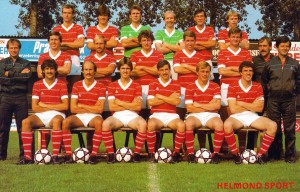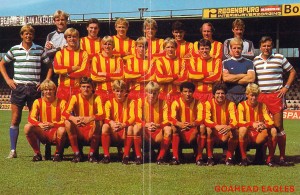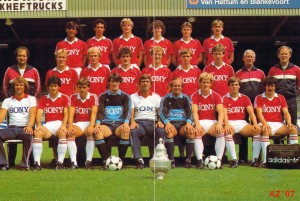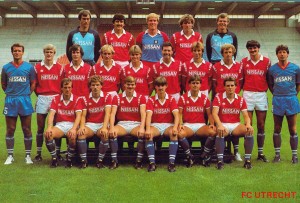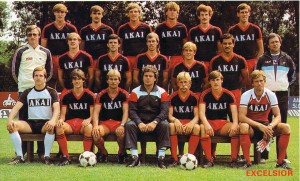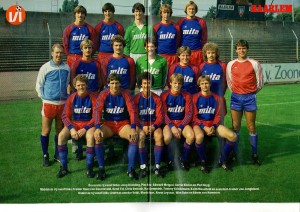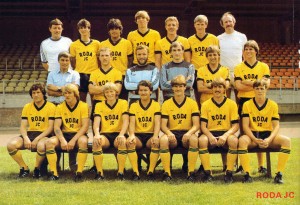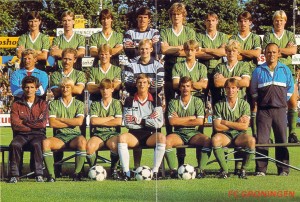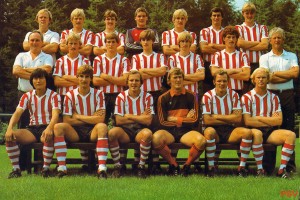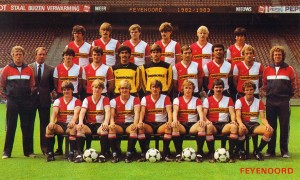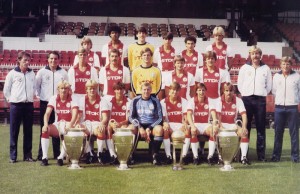There was something ‘unBritish’ noticed and voiced out: a superclub’s domination. It was hardly Liverpool’s fault, but pundits criticized that England became like ‘the continentals’. The most exciting aspect of English football – that it was unpredictable and anybody could win over big teams was lost. It was not fun to know in advance who will win, was the complaint. And evidence supported it. Especially this season.
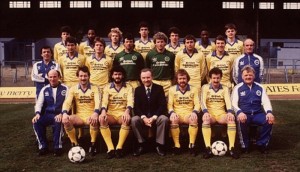 Brighton & Hove Albion finished 22nd with 40 points. Back row: Giles Stille, Chris Ramsey, Neil Smillie, Gary Stevens, Graham Pearce, Terry Connor, Gary Howlett.
Brighton & Hove Albion finished 22nd with 40 points. Back row: Giles Stille, Chris Ramsey, Neil Smillie, Gary Stevens, Graham Pearce, Terry Connor, Gary Howlett.
Middle row: Mike Yaxley (physio), Gordon Smith, Steve Gatting, Graham Moseley, Perry Digweed, Michael Robinson, Sammy Nelson, Glen Wilson (kit man).
Front row: Jimmy Melia (manager), Jimmy Case, Steve Foster, Mike Bamber (chairman), Tony Grealish, Gerry Ryan, George Aitken (coach).
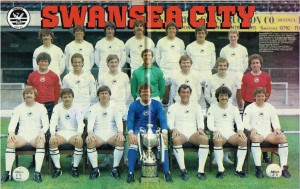 With 41 points, Swansea City ended 21st. Both the Seagulls and the Swans had miserable season and went down., despite the fact they were helped by former Liverpool greats – Jimmy Case (Brighton) and Ray Kennedy (Swansea).
With 41 points, Swansea City ended 21st. Both the Seagulls and the Swans had miserable season and went down., despite the fact they were helped by former Liverpool greats – Jimmy Case (Brighton) and Ray Kennedy (Swansea).
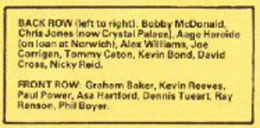 The crisis of Manchester City was detected already a few years back and this season it reached inevitable end: Manchester City fought, but was relegated. 20th with 47 points.
The crisis of Manchester City was detected already a few years back and this season it reached inevitable end: Manchester City fought, but was relegated. 20th with 47 points.
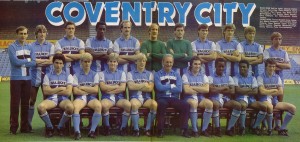 Coventry City survived – 19th with 48 points. Dave Sexton did what he could at the helm, Gerry Francis helped, whenever his injuries gave him a chance to play. Coventry was survivor, but the future was not promising.
Coventry City survived – 19th with 48 points. Dave Sexton did what he could at the helm, Gerry Francis helped, whenever his injuries gave him a chance to play. Coventry was survivor, but the future was not promising.
 Luton Town escaped relegation, which was pretty much the best the modest club could achieve. 18th with 49 points.
Luton Town escaped relegation, which was pretty much the best the modest club could achieve. 18th with 49 points.
Like Luton, Birmingham was mostly concerned with survival – and they succeeded. 17th with 50 points.
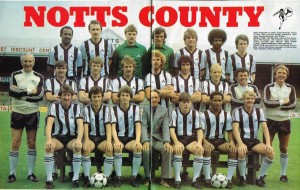 Notts County – 16th with 52 points. One more small club just bravely avoiding relegation.
Notts County – 16th with 52 points. One more small club just bravely avoiding relegation.
 Sunderland – 15th. Well, this is a mistake in some publications, if not something more serious. Sunderland finished with 50 points – 2 less than Notts County. If true, they must be bellow – 16th. In some tables they are 16th, in others – 15th. Apart from the problem with accuracy, no big deal – the squad belonged to this area of the league.
Sunderland – 15th. Well, this is a mistake in some publications, if not something more serious. Sunderland finished with 50 points – 2 less than Notts County. If true, they must be bellow – 16th. In some tables they are 16th, in others – 15th. Apart from the problem with accuracy, no big deal – the squad belonged to this area of the league.
 Norwich City – 14th with 54 points. Not bad for newcomers, but they completed a group of clubs obviously weaker than most and concerned only with brief survival.
Norwich City – 14th with 54 points. Not bad for newcomers, but they completed a group of clubs obviously weaker than most and concerned only with brief survival.
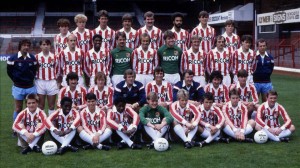 Stoke City – 13th with 57 points – belonged to another section of the league: seemingly solid, but no more than that, teams in the middle of the table. Decline, rather than improvement, was detected in that group.
Stoke City – 13th with 57 points – belonged to another section of the league: seemingly solid, but no more than that, teams in the middle of the table. Decline, rather than improvement, was detected in that group.
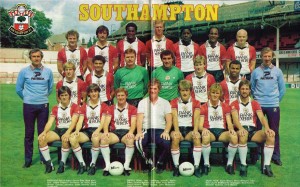 Southampton – also with 57 points, but 12th. Their idea of keeping afloat by buying famous veterans was more than risky, but the club seemingly could not get wiser: Keegan was gone, Peter Shilton was in, they dropped down, but were outside danger. The problem with their policy was simple one: depending on momentary form, the team was able to produce strong season. If not – at least they were not in imminent danger. But such a policy could misfire any moment.
Southampton – also with 57 points, but 12th. Their idea of keeping afloat by buying famous veterans was more than risky, but the club seemingly could not get wiser: Keegan was gone, Peter Shilton was in, they dropped down, but were outside danger. The problem with their policy was simple one: depending on momentary form, the team was able to produce strong season. If not – at least they were not in imminent danger. But such a policy could misfire any moment.
West Bromwich Albion – 11th with 57 points. Better goal-difference placed them above Southampton and Stoke City, but there was no mistake – WBA was going down. A few years back they were bright, promising team, climbing up, but they got no better. Now it was just a question how long they would be able to keep their leading players, like Cyrille Regis. Since worthy replacements were not in place… the direction was only one: downhill.
 58 points meant 10th place. What to say… this squad should have been a title contender. But this is Arsenal…
58 points meant 10th place. What to say… this squad should have been a title contender. But this is Arsenal…
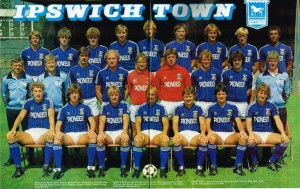 Ipswich Town – 9th with 58 points. Above Arsenal on better goal-difference. Their wonderful period was over, now was time for decline and suffering. Losing key players, getting older, that was that.
Ipswich Town – 9th with 58 points. Above Arsenal on better goal-difference. Their wonderful period was over, now was time for decline and suffering. Losing key players, getting older, that was that.
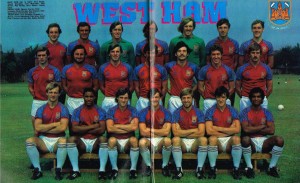 West Ham United made a good illusion of recovery – they were 8th with 66 points. Illusion, because their good spell depended largely on veterans – Trevor Brooking, Billy Bonds, Frank Lampard, Phil Parkes, and Belgian Francois van der Elst. They looked eternal, but were not. Well over 30 years old.
West Ham United made a good illusion of recovery – they were 8th with 66 points. Illusion, because their good spell depended largely on veterans – Trevor Brooking, Billy Bonds, Frank Lampard, Phil Parkes, and Belgian Francois van der Elst. They looked eternal, but were not. Well over 30 years old.
 Everton – 7th and ahead of the Hammers only on goal-difference. They were under the radar for some time and just as good – the team was quietly shaping and rising, but nobody paid attention, so Everton was able not only to keep, but also to add talent and refine the team. The only one of the mid-table group going up.
Everton – 7th and ahead of the Hammers only on goal-difference. They were under the radar for some time and just as good – the team was quietly shaping and rising, but nobody paid attention, so Everton was able not only to keep, but also to add talent and refine the team. The only one of the mid-table group going up.
And finally the top 6, subdivided into two uneven parts – 5 strong teams and one superstrong and out of reach.
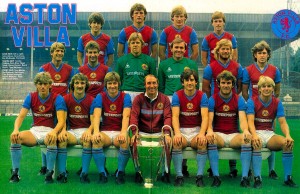 Aston Villa was 6th with 68 points. European champions and all that, but it was clear that the team was one-time wonder, now running on inertia. Not dynasty builders, that was sure. It was practically the same team, which won the title in 1980-81 and that was precisely the verdict: forget about adding new big talent; nobody was particularly lusting after members of champion squad. No particularly great talent to begin with… therefore, their good spell could not last long. They were not getting better, they already reached their peak.
Aston Villa was 6th with 68 points. European champions and all that, but it was clear that the team was one-time wonder, now running on inertia. Not dynasty builders, that was sure. It was practically the same team, which won the title in 1980-81 and that was precisely the verdict: forget about adding new big talent; nobody was particularly lusting after members of champion squad. No particularly great talent to begin with… therefore, their good spell could not last long. They were not getting better, they already reached their peak.
Nottingham Forest was holding up – 5th with 69 points. Unlike Aston Villa, Brian Clough tried to reinforce his original squad, but Nottingham did not have enough money to really built formidable team. Spending had to be countered with some income, which had to come from selling stars. So far, no major problems on the horizon – Peter Shilton went to Southampton, but Dutch goalkeeper Hans van Breukelen was recruited. On the surface, Clough had very good eye… if it was 1988, not 1982, and if prejudice was not so strong. Like the Swiss international Raimondo Ponte a bit earlier, van Breukelen did not last, nor his spell was memorable. Clough was singing the song that his squad lost interest after winning everything in the world, but one can easily point at Liverpool – they won more trophies than mercurial Forest and still remained hungry for more.
Perhaps the only formidable example of up and coming team, the Spurs finished 4th with 69 points. However, their rapid development may have been cut short this very season – the sour point was that it was not some mistake of the club, but something entirely out of their control. The Falklands War… Tottenham immediately got involved: Osvaldo Ardiles not only played for them, but was instrumental for their bright new team. But he had to go, at least for the lasting of the war. How long a war lasts? This nobody could tell, yet, both club and player did not want to part ways. Ossie was loaned to Paris SG. But he was not around for the season and his absence very likely arrested the development of the squad.
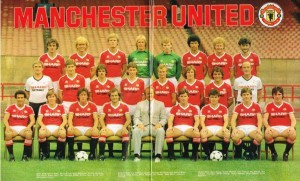 Manchester United – 3rd with 70 points. One can look at this squad with either anger, or confusion: not only highly talented, but perhaps deeper than what Liverpool had. Forger about Macari, Buchan, even McQueen and Coppell – here were the top current players in England: Bryan Robson, Norman Whiteside, Frank Stapleton, Ray Wilkins, Gary Bailey. Young talent was pushing up as well – Kevin Moran, Remi Moses, Paul McGrath. And Arnold Muhren was just added to the bunch. It was such a squad, United was able easily to let go Garry Birtles. Yet, this squad was not a title contender. Looked like a curse – Manchester United had teams full of big names and highly promising youngsters since 1972 and got nothing. Ron Atkinson had to go… no matter what, one thing he failed to deliver: a title.
Manchester United – 3rd with 70 points. One can look at this squad with either anger, or confusion: not only highly talented, but perhaps deeper than what Liverpool had. Forger about Macari, Buchan, even McQueen and Coppell – here were the top current players in England: Bryan Robson, Norman Whiteside, Frank Stapleton, Ray Wilkins, Gary Bailey. Young talent was pushing up as well – Kevin Moran, Remi Moses, Paul McGrath. And Arnold Muhren was just added to the bunch. It was such a squad, United was able easily to let go Garry Birtles. Yet, this squad was not a title contender. Looked like a curse – Manchester United had teams full of big names and highly promising youngsters since 1972 and got nothing. Ron Atkinson had to go… no matter what, one thing he failed to deliver: a title.
 It was a surprise, but wonderful one – Watford finished 2nd with 71 points. Rarely a debutante ends that high.
It was a surprise, but wonderful one – Watford finished 2nd with 71 points. Rarely a debutante ends that high.
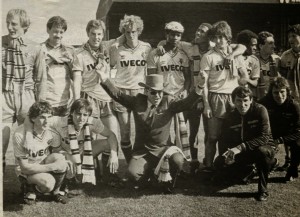 Of course, none the happier than Elton John. The power of rock’n’roll materialized. It was spectacular climb from 4th division obscurity to the top, a true rock’n’roll story. Wonderful work by Graham Taylor, who just trusted his unknown players and was trusted back. Now the anonymous players were getting recognition, particularly Luther Blissett and John Barnes – and with that, danger. Evan with Elton John as chairman, Watford was small club and with small budget. A club liable to sell, not to buy. Now the focus was on them and the new stars were more than likely to go elsewhere – but the club was unable to replace them easily. It was immediate problem, but still had to wait a bit – the big success had to be enjoyed first, for it was magical moment.
Of course, none the happier than Elton John. The power of rock’n’roll materialized. It was spectacular climb from 4th division obscurity to the top, a true rock’n’roll story. Wonderful work by Graham Taylor, who just trusted his unknown players and was trusted back. Now the anonymous players were getting recognition, particularly Luther Blissett and John Barnes – and with that, danger. Evan with Elton John as chairman, Watford was small club and with small budget. A club liable to sell, not to buy. Now the focus was on them and the new stars were more than likely to go elsewhere – but the club was unable to replace them easily. It was immediate problem, but still had to wait a bit – the big success had to be enjoyed first, for it was magical moment.
 Watford was in everybody’s mouth this season, but they did not come even close to the title. It was irritating for many observers, but Liverpool had no rival. Let face it – wonderful Watford was quite out of their depth and wonderful as they were, they lost 15 games. Liverpool lost only 8. Watford run on risk – push ahead for win-or-lose and they came second thanks to winning 22 matches. Liverpool did not have to play adventurers football – they were simply too strong for that and won 24 matches. What was there to argue about: 12 national team players here and that if Terry McDermott is not counted. Not counted, for Liverpool transferred him without a blink – with so much talent, no problem transferring anybody. Graeme Souness now ruled, making Kenny Dalglish yesterday’s news, Kevin Keegan distant memory, Emelyn Hughes – ancient history, and John Toshack – prehistory. Souness himself was close to oblivion… for Jan Rush was coming up rapidly as the tomorrow’s superstar. There was no end… and not just on the field. Bill Shakly was slipping out of mind by now, for Bob Paisley ruled. He ruled, but Joe Fagan was already at hand. Liverpool changed English football – never before them the birthplace of the sport was dominated by one big club. Liverpool made England just like all that ‘continental’ countries, grumbled pundits and fans outside Liverpool – the club and its supporters had nothing to object, they basked in glory. And rightly so – Liverpool just started a third consecutive decade of success. It was incredible, perhaps unmatched consistency.
Watford was in everybody’s mouth this season, but they did not come even close to the title. It was irritating for many observers, but Liverpool had no rival. Let face it – wonderful Watford was quite out of their depth and wonderful as they were, they lost 15 games. Liverpool lost only 8. Watford run on risk – push ahead for win-or-lose and they came second thanks to winning 22 matches. Liverpool did not have to play adventurers football – they were simply too strong for that and won 24 matches. What was there to argue about: 12 national team players here and that if Terry McDermott is not counted. Not counted, for Liverpool transferred him without a blink – with so much talent, no problem transferring anybody. Graeme Souness now ruled, making Kenny Dalglish yesterday’s news, Kevin Keegan distant memory, Emelyn Hughes – ancient history, and John Toshack – prehistory. Souness himself was close to oblivion… for Jan Rush was coming up rapidly as the tomorrow’s superstar. There was no end… and not just on the field. Bill Shakly was slipping out of mind by now, for Bob Paisley ruled. He ruled, but Joe Fagan was already at hand. Liverpool changed English football – never before them the birthplace of the sport was dominated by one big club. Liverpool made England just like all that ‘continental’ countries, grumbled pundits and fans outside Liverpool – the club and its supporters had nothing to object, they basked in glory. And rightly so – Liverpool just started a third consecutive decade of success. It was incredible, perhaps unmatched consistency.
